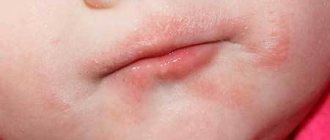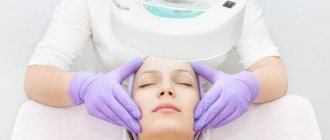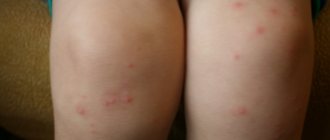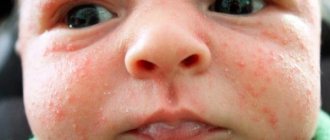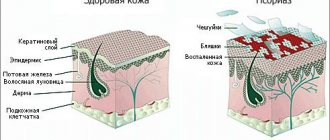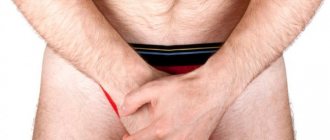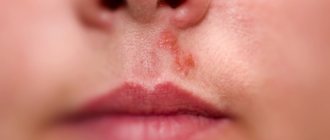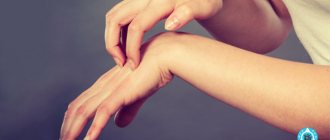Rash on the palms - a harmless symptom or a serious diagnosis?
Having discovered a rash on the palms of a child, caring parents usually immediately begin to sound the alarm. Rashes are often caused by diseases, often of an infectious nature, threatening the health and even the life of the baby. Sometimes they are quite harmless and go away on their own. In any case, the child’s body signals about violations occurring inside. It is the responsibility of parents and doctors to understand what a rash is and why it appears.
Help with rashes on palms
If you notice problems in your feet, you should not start treatment on your own. In order not to disturb the clinical picture and not to complicate the diagnosis, you should not lubricate the rashes with agents that significantly change their appearance (iodine, brilliant green, fucorcin).
Do not forget that there is no general treatment regimen for such rashes. All appointments will depend on the reason for which such a lesion occurred.
Before visiting a doctor at home, it is necessary to ensure that the affected surfaces are kept at rest. This will help avoid damage. In addition, you need to keep your skin clean and dry (if possible). It is important to be treated strictly following your doctor's instructions. All procedures that will have to be performed will be aimed at getting rid of the underlying ailment. Each of the pathological processes manifested by such changes in the hands has its own treatment regimen. There are often cases when the disease that caused such skin damage can only be gotten rid of in a hospital setting.
A rash on the palms indicates that there has been a disruption in the normal functioning of the body. The causes of rashes are often diseases of internal systems and organs, allergic reactions and even the common cold. Along with the rash, itching and burning occur on the palms, which irritate and interfere with everyday activities.
Types of rashes
The rash in children, located on the inside or outside of the palms and noticeable to the naked eye, differs in color, severity, structure and arrangement of elements:
- bubbles - small or large swellings of the skin, filled with clear liquid inside;
- pustules - similar to vesicles, but contain pus inside;
- papules - nodular elements in the thickness of the skin;
- spots - accumulations of small elements located on the same level with the general surface of the skin;
- blisters are dense, rough elements that rise above the general level of the skin;
- erosions, ulcers – violations of the integrity of the skin in depth, accompanied by discharge.
Important points before the doctor arrives
If any of the above types of rash are detected on the palms of the hands, parents should record other possible symptoms:
- increase in general body temperature;
- the appearance of clear nasal discharge;
- coughing;
- nausea;
- pain in the stomach or throat;
- urge to vomit;
- lethargy;
- reluctance to eat.
You should also note the possible presence of a rash on the child's feet, legs, or mouth. If nothing is observed, it is necessary to remember and write down what food the child previously ate, what objects he played with and held in his palms. It is important to promptly note the child’s contact with a sick person and the possibility of infection.
All additional symptoms and knowledge will help make a quick and correct diagnosis.
Why does the rash appear?
Every parent is afraid of the symptoms associated with a rash, because often identifying and eliminating the cause of the manifestation is not easy and only a specialist can do it. Pediatricians advise studying the main factors that may cause rashes on the baby’s skin. This will help you follow preventive measures and, in case of unfavorable symptoms, understand what could be the impetus for the development of an allergic reaction or other pathology.
The above factors relate to the general manifestations of a rash in a child, but what to do if the location of the rash is specific - on the palms and soles? Symptoms may indicate serious skin lesions or infectious pathologies. In order to take timely measures to eliminate the disease, it is worth carefully studying the main diseases and the causes that lead to this phenomenon.
Causes of the rash
In most cases, the factors leading to rashes are:
- Infectious diseases - accompanied by signs characteristic of acute respiratory infections, occurring along with a rash or after a few days. The most common diseases with a rash on the palms of the palms:
- chickenpox (smallpox) – spots that appear at first quickly turn into blisters up to 5 mm in size, the rash usually itches; located on the palms, face, head, torso, in the mouth;
- rubella - many small spots localized mainly in the folds of the arms and legs, on the outer side of the palms, they are accompanied by signs of intoxication;
- measles - a rash appears after a rise in temperature and other signs of infection, starting from the head, then moving to the torso, palms, arms, legs; the spots are red, large, merging;
- scarlet fever - rashes in the form of small dots appear after the appearance of signs of sore throat on the second day; especially abundant in skin folds, folds, on the outside and between the fingers;
- Allergic reaction. Hives on the palms of a child appear after he has directly touched the allergen or ingested it. Substances that cause allergies: dairy products, sweets, medications, animal hair, dust, cream, powder, etc. The rash is bright red, raised, itchy; detected with a runny nose, sneezing and other manifestations of allergies.
- Diseases from insect bites, parasites. Classic examples would be bites from mosquitoes, bees, and wasps, to which the child is allergic. The most common parasite that causes a rash that itches and appears between the fingers, palms, and genitals is the mite. The disease is contagious and is called scabies. Multiple mosquito bites, flea bites, or jellyfish stings should be distinguished from a rash.
- Diseases of the circulatory system. The rash is quite characteristic, hemorrhagic, and occurs due to the destruction of small vessels and effusions into the skin. It looks like a bruise or small rash in the form of dots.
- Poor hygiene. As a result, it leads to the appearance of diaper rash, dermatitis, and prickly heat on the back of the hands. Constantly taking air baths, frequent bathing and timely changing of diapers will help to avoid problems.
If redness appears on the legs or palms, similar to a rash, the baby may have come into contact with nettles. Observe your children carefully while out and about at home, the overall picture will help the medical report.
Treatment
First of all, it is necessary to perform a diagnostic examination, identifying the causes that provoked an acute allergic reaction. After identifying the allergen, a course of treatment is prescribed, which is aimed at relieving allergic symptoms and preventing possible relapses.
- In the case where the causes of negative manifestations arise from food, the doctor prescribes a hypoallergenic diet. In addition, if a severe reaction develops, infusion therapy is recommended to remove toxic substances from the blood;
- To relieve allergic manifestations, a number of long-acting antihistamines are first prescribed. Recently, treatment most often uses third-generation drugs: Loratadine, Fenistil, etc. These drugs have a minimal number of side effects and do not have a sedative effect on the nervous system. This is especially important when treating a child;
- in case of severe development of an allergic reaction, treatment involves the use of hormonal drugs orally and for external use. As a rule, the ointment is applied directly to the palm itself in a very thin layer. The most effective use of external preparations such as Gistan, Fenistil-gel, Desitin. These drugs effectively relieve skin manifestations in the form of inflammation, redness, itching and are approved for use even for children;
- in particularly difficult cases, the allergic process may be accompanied by a suppurative process as a result of pathogenic microflora entering the wound surface. In this case, antibiotic therapy with simultaneous blocking of the inflammatory process is recommended. To do this, you can use ichthyol and Vishnevsky ointment.
It is important to remember that self-treatment of allergies on the surface of the hands is strictly prohibited. All therapeutic measures are carried out only after the appointment of the attending physician. This is due, first of all, to the individual sensitivity of the body and it is likely that medications for an adult patient are not suitable for treating a child. Therefore, the dosage and choice of antihistamines depends on the age of the patient and the state of the immune system.
Fighting rashes
Treatment options must be prescribed by a doctor after a thorough examination and accurate identification of the causes of the rash:
- if the disease is caused by a virus, specific treatment, as a rule, is not required;
- for infections caused by bacteria, a course of antibiotics is required;
- allergic rashes require avoidance of further contact with the allergen and the use of antihistamines;
- vascular diseases are more accurately diagnosed by a hematologist;
- Scabies will require a trip to the dermatologist.
The use of creams, ointments, balms prescribed by the doctor will relieve itching accompanied by rashes.
Do not neglect childhood vaccinations, maintain hygiene, try not to overload your child with sweets and respond in a timely manner to any rashes on the palms, feet, and legs - these are the best preventative measures against rashes.
Urticaria on the hands: photos in children and adults, treatment, causes and symptoms
The condition and appearance of the skin can tell a lot about a person’s well-being and health. Hidden internal diseases and pathological conditions are manifested by various skin problems.
One of these problems is an unpleasant disease - urticaria on the hands.
Bright spots are noticeable to others, which brings moral discomfort, especially to the fair sex. The painful itching is difficult for children to endure. The disease requires immediate treatment. And for this it is necessary to correctly determine which factors served as the trigger for the development of the disease.
Causes of urticaria on the hands
Hives are a condition that can be caused by many causes.
The main role in the mechanism of the appearance of a rash in the form of urticaria on the hands belongs to histamine. Histamine is a biologically active substance that is found in the form of granules inside white blood cells (mast cells).
Under the influence of various substances that enter the body or external factors, histamine is released by mast cells. Free histamine causes swelling and inflammation of the tissue at the site of release, and the formation of blisters on the skin.
There are 2 main pathways for the release of histamine from mast cells, which trigger the onset of urticaria:
Urticaria on the hands occurs as an immune response:
After eating certain foods (citrus fruits, chocolate, nuts, fish, egg whites, red berries). After an insect bite (mosquitoes, bees). After contact with certain substances and materials (household chemicals, cosmetics, metal jewelry, synthetic clothing).
After inhalation of volatile gaseous substances (perfume, aerosols), dust, plant pollen. After vaccination. After exposure to external factors (cold, heat, water, ultraviolet radiation, friction, vibration). After stressful situations, physical activity.
Features of urticaria on the hands of children
Hives on the hands of children are quite common. In most cases, the disease goes away on its own and does not require serious treatment. Nevertheless, it is imperative to show the child to a pediatrician.
The most common cause of hives in children is food allergies. To quickly determine which food product a reaction occurred to, you need to keep a food diary. New treats should be offered to the child in small quantities, no more than one type per day. A nursing mother should also adhere to a hypoallergenic diet during lactation.
A child may have an allergic reaction to pet fur. If this happens, it is better to remove the pet from the house for a while. Perhaps as you grow older, the situation will change.
Another cause of urticaria in children is post-vaccination complications. Characteristic rashes may appear as a reaction to one of the components of the vaccine.
Important.
Children should not be vaccinated at home. Urticaria can be accompanied not only by local edema, but also by general angioedema (Quincke's edema). Only immediate medical attention will help avoid death.
Urticaria on the hands of a child and an adult, as can be seen from the photo, has similar symptoms and prerequisites for treatment.
The doctor chooses the treatment methods taking into account the child’s age and the severity of the disease. To relieve itching, cooling creams and ointments may be prescribed. Bathing in a bath with the addition of decoctions of medicinal herbs (chamomile, string, calendula) helps well. Also, it is necessary to ensure that the child does not scratch the blisters and does not introduce additional infection into the wounds.
Treatment of urticaria on the hands
Considering the multifactorial pathogenesis of urticaria on the hands, only a doctor can decide how to treat the disease.
The standard treatment regimen includes the following steps:
Visual examination, medical history, determination of the cause of the disease. Eliminate contact with the provoking factor or substance. Cleansing the body of allergens. For this purpose, sorbent preparations are used.
Relieving adverse symptoms with medications. Medicines are selected by trial method, according to the principle of gradually enhancing the current effect in the following sequence:
- Il generation antihistamines in minimal dosage;
- Il generation antihistamines in increased dosage (maximum 4 times);
- combining antihistamines of different generations;
- hormonal drugs; immunosuppressants.
Carrying out diagnostic measures to identify other chronic diseases and their treatment. Teaching the patient preventive measures to prevent relapses.
Types of rash
In a child, a rash on the feet and palms is classified according to the secretion contained in the blisters or its absence:
- Spots - formed on the skin in single or mass quantities. Color – pale pink.
- Papules - nodular formations appear in the middle layers of the epidermis.
- Pustules - a purulent process in the dermis leads to the formation of large blisters.
- Blisters - the rash contains a clear and liquid secretion.
- Blisters are noticeable round subcutaneous blisters with a rough surface.
- Erosion - damage appears on the surface of the epithelium, leading to the release of ichor.
Dyshidrosis
Another disease characterized by the formation of rashes on the palms. Most often it affects people prone to allergic reactions, as well as those with a genetic predisposition to it. The exact causes of this disease have not yet been precisely established, so it is customary to identify factors that contribute to its development. Among them are decreased immunity, disturbances in the functioning of the central nervous system, dysfunction of the digestive and endocrine systems.
As a rule, dyshidrosis is chronic. Its symptomatic picture and nature of development includes the following signs:
- a subcutaneous rash appears on the palms;
- the size of each formation does not exceed 2 – 3 mm;
- rashes can merge with each other;
- formations are filled with liquid contents;
- after opening them, erosions, crusts, etc. remain.
- the whole process is accompanied by itching.
Treatment of the disease comes down to relieving symptoms and restoring the quality of the skin. In case of scratching the affected areas and causing a secondary infection, therapy is prescribed separately.
Considering that it is impossible to guarantee the recurrence of dyshidrosis, you should follow the rules for the prevention of this disease. First of all, take good care of the skin of your hands, avoid hypothermia and direct contact with aggressive substances. Systematically apply a softening and nourishing cream to the skin. And use available means to strengthen the immune system. But the main thing is to try to avoid strong, systematic stress.
Causes of rashes
A rash on the palms of a child is a natural reaction of the body to the consequences of insufficient hygiene. But the causes of skin spots can be much more serious.
Infectious diseases
The incubation period of many infectious diseases is quite long. After contact with a sick person, there is time to prepare and carefully monitor the condition of the skin.
Infectious diseases that provoke changes in the structure of the epidermis:
- Chickenpox - itchy blisters with clear liquid are localized on the head, gradually covering all parts of the body, including the feet and palms. In mild cases, body temperature rises slightly. In severe cases of the disease, chills, nausea, and enlarged lymph nodes appear.
- Rubella - a red rash on the palms of a child occurs after the rash on the face. It can cover the entire body. During rubella, the baby may complain of pain in the joints and muscles, and he will develop photophobia.
- Measles - large red spots cover the entire body, over time, single copies merge into one. Before the appearance of rashes in the form of red dots, symptoms of a common ARVI are observed, later conjunctivitis develops.
- Scarlet fever - a small rash covers the neck and face, descending further down the body. Before its appearance, streptococcal sore throat develops. The baby feels weak and nauseous.
- Meningitis - the toxin of meningococcus paralyzes blood vessels, this leads to the formation of local hemorrhages on the skin. The baby develops a rash, body temperature rises, and a severe headache.
All of these diseases require medical supervision and placement of the small patient in the infectious diseases department of the hospital.
Allergic reaction
If infectious diseases are excluded, but formations in the form of bubbles remain on the palms and soles, then there is a possibility of developing an allergic reaction.
The skin reacts to:
- contact with household chemicals - powder and conditioner for washing clothes and children's clothes;
- food products - milk, citrus fruits, eggs, berries, honey and others;
- tap water – high chlorine content;
- animal hair and saliva - dogs, cats;
- house dust – it contains waste products of bed mites.
Young children cannot talk about what worries them. But spots on the palms and soles of the feet cause itching during an allergic reaction.
That's why kids constantly scratch their hands and heels on any surface, and sometimes try to bite their palms. This behavior should alert parents.
Parasitic infestation
There are times when parents are confused and do not understand the reasons for the appearance of spots in their child. They ask the pediatrician what it could be and how to eliminate skin problems. And it turns out that the rashes are the result of helminths multiplying in the body.
They are parasitic microorganisms that produce toxins that the immune system tries to fight. As a result of the production of protective cells of the epidermis, an allergic rash appears, which itches and inflames nearby tissues.
The presence of parasites is manifested by symptoms:
Sensitive children's skin is a favorable environment for the activity of fungal bacteria. Their active reproduction on the skin leads to skin rashes - pimples on the feet and palms turn into erosion and peel off.
Rash on the palms of an adult
There are many reasons for the development of rashes on the skin of the palms of an adult. Among them are external influences and internal causes associated with diseases. The rash appears as a result of:
- contact dermatitis;
- autoimmune pathologies – psoriasis, rheumatoid arthritis;
- infections - syphilis, rubella, measles, mumps, meningitis;
- anaphylactic shock;
- food allergies;
- insect bites;
- aggressive environmental action;
- influence of allergens;
- chemical burns;
- stress;
- cold, warmth.
Pimples
The appearance of such formations on the face and other parts of the body is not surprising. The palms are a special case – there are no sebaceous glands there. Only their inflammation provokes the formation of acne. Why does a rash appear on the palms? Reasons for this phenomenon:
- allergic reactions;
- side effects of medications;
- gastrointestinal pathologies;
- excessive sweating;
- enterovirus infection;
- scabies;
- chickenpox;
- stressful situations;
- lack of hygiene;
- fungal skin infections.
The appearance of acne on the palms requires contacting a dermatologist. The doctor will determine the cause of the rash and prescribe:
- treatment of the underlying disease;
- the use of ointments that relieve unpleasant skin symptoms;
- use of medications – tablets, injections;
- diet;
- preventive measures to prevent recurrence of rash formation.
Pimples
The appearance of small watery blisters is evidence of problems in the body. When pimples appear on the palms and itch, you need to visit a dermatologist to establish a diagnosis and prescribe treatment. The causes of the rash are:
- scarlet fever;
- chronic eczema;
- typhus;
- venereal diseases;
- dyshidrosis;
- emotional turmoil;
- stress;
- insect bites;
- chemical burns;
- action of bacteria and viruses.
- Pilaf in a pan with chicken
- How to Calm the Nervous System with Autogenic Training
- How to clean a sheepskin coat at home
One of the reasons for the appearance of pimples on the palms is dyshidrotic eczema. The disease is characterized by acute development, which is provoked by contact with chemicals in everyday life, cosmetics, and washing powders. Once it appears in the body, even after a course of treatment, it can reappear for no reason. In addition to the rash, it is possible:
- enlarged lymph nodes;
- appearance of weakness;
- temperature increase;
- development of painful symptoms.
Red rash
Why does a child develop a rash on his palms? The cause of red dots is prickly heat; in infants, diaper dermatitis and chickenpox. A reaction to household laundry detergents or the introduction of new complementary foods is possible. For adults, a possible cause is erythema - pinpoint redness caused by dilated capillaries. In appearance they may be:
- hard pimples - papules;
- nodules – dense rashes more than 5 mm;
- blisters with white spots of pus - pustules;
- plaques are formations tending to merge;
- blisters are individual watery fragments of the rash over 0.5 centimeters.
Prickly heat
When, for some reason, a person begins to actively produce sweat, and evaporation is impaired, prickly heat develops. It is often observed in hot weather. There are 3 types of rash on the skin of the palms:
- small bubbles, contents – pearlescent – crystalline;
- the appearance of red spots, followed by infection, suppuration - red;
- penetration of inflammation deep into the skin, blockage of sweat glands, their rupture, development of microbial eczema - deep.
Dermatologists consider diseases and external factors to be the causes of prickly heat on the palms. Causes of rash:
- thermoregulation disorders caused by nervous and endocrine pathologies;
- infections;
- intoxication of the body;
- obesity;
- heavy physical activity;
- diseases of the heart and blood vessels;
- synthetic clothing;
- use of oily cosmetics that impair skin breathing;
- the need to work with gloves;
- high temperature outdoors, indoors.
Ulcers
A factor in the spread of pustular rash on the palms is dyshidrosis, a type of eczema. The formation is accompanied by pain and severe itching. Skin diseases are characterized by:
- the appearance of redness, swelling;
- the appearance of bubbles with clear liquid;
- their subsequent damage;
- formation of ulcers;
- development of thickenings, cracks;
- with the ingress of viruses and bacteria - purulent inflammation;
- probable infection of the entire body.
Help a child
To confirm the diagnosis, the pediatrician will prescribe blood and urine tests, scrapings for microflora and tests for allergens. Depending on the result, effective therapy is prescribed, aimed at relieving symptoms and combating a specific disease. But before a diagnosis is made, parents should help the child get rid of discomfort.
To do this, you should take measures:
- If the problem is not accompanied by any additional symptoms, then the inflamed areas can be lubricated with a children's itching reliever - Advantan, Lokoid.
- For newborns, you can pour a decoction of string or chamomile into the bath.
- If the child is allergic, they are given an antihistamine for 5 days - Suprastin, Tavegil, Erius. Its dosage depends on the age and weight of the baby.
- Eliminate contact with the allergic substance. If this is a food product, then it is prohibited to give it to a child. If possible, exclude animals from the house and carry out general cleaning to get rid of dust.
- Rashes caused by a bacterial infection are treated with antibiotic medications.
If the baby’s feet and palms become covered in spots, and his body temperature rises to critical levels, then parents should urgently call for medical help.
Traditional methods of treatment
A decoction of ten grams of birch buds helps well .
The raw material is poured with a glass of boiling water and boiled for twenty minutes. Use cool liquid to wipe irritated, itchy areas affected by eczema. Oak bark . Twenty grams of oak bark are poured with water in a volume of two hundred milliliters. Cook for half an hour in a water bath. Then immediately filter, after adding boiled water so that the volume does not decrease.
Tibetan decoction of grape leaves is easy to prepare and effective for external rashes. A tablespoon of dry leaves is poured with two hundred milliliters of boiling water in an enamel container. Cook for ten minutes.
Even if you eliminate rashes and itching at home on the palms and feet of children and adults, you cannot guarantee that a relapse will not occur. You should not try to get rid of rashes with brilliant green. This will only complicate the diagnosis.
Before visiting a doctor, the affected areas should be kept clean, dry, and rested to avoid damage to the skin. Each individual case of a rash requires a special treatment regimen, which can only be prescribed by a specialist.
Preventive measures
Having looked at the photos with explanations on the Internet pages showing the types of skin rashes, the mother should do everything to prevent her child from having such skin problems.
For this, preventive measures are necessary:
- timely vaccination;
- children's clothing - natural and high quality;
- If you are prone to allergies, do not have pets;
- regular wet cleaning of the house;
- long walks in the fresh air;
- strengthening the immune system;
- taking vitamin complexes;
- compliance with hygiene rules.
Causes of blistering rashes
The most dangerous cause of a blistering rash on the palms and soles of a baby is meningococcal disease. When Neisseria meningitidis viruses enter the child’s body, the blisters bleed, the baby’s general condition sharply worsens, and a fever begins.
Lack of timely treatment often leads to death. A child's rash on the palms and feet in blisters of various types is shown in the photo. It is important to see the differences between different rashes. The main reasons for the appearance of a blistering rash:
- Allergy. It is caused by contact with house dust, stray animals, garden and field plants, and the appearance of new foods in the diet.
- Worm infestation.
- Bites by parasites and insects.
- Scabies, which is caused by the bite of a scabies mite. The child is worried due to constant itching, especially severe at night. This disease requires isolation of the child from other children.
- Inflammation of blood vessels and capillaries. In this case, the diagnosis is hemorrhagic rash. She is treated only in infectious diseases departments under the constant supervision of doctors.
- Measles, chickenpox.
- Diaper dermatitis, prickly heat.
- The beginning of the development of psoriasis.
Blistering rashes can be a sign of disease of the heart, blood vessels, and liver. Often neglected prickly heat develops into blistering rashes if hygiene rules are not followed. The doctor understands why a rash in the form of blisters appears on a child’s palms and feet, and he often takes photos to add to his collection of work experience.
Advice!
Before visiting a doctor, the child does not need to treat the rash with ointments or brilliant green so that the dermatologist sees a clear clinical picture.
Features and causes of the rash
A rash in a child always causes concern for parents, but a specialist can correctly diagnose and recognize it. Therefore, if you notice a rash on your child’s feet and palms, consult a doctor who will conduct an examination and determine the causes of this phenomenon.
The most common causes of a rash in a baby include the following:
- allergic reaction;
- infectious dermatological diseases;
- the presence of parasites in the child’s body.
Rashes can also be associated with ordinary poor hygiene.
However, such a phenomenon may be evidence of the presence of diseases such as chickenpox, measles or scabies. You should pay attention to the fact that with such diseases, the rash begins to spread throughout the body over time. Scabies is also characterized by the formation of subcutaneous passages, which are formed by the scabies mite. When measles occurs, the baby not only develops a rash, but also a high body temperature. Chickenpox is different in that the rash can quickly spread throughout the body, and blisters also appear on the skin. During rubella, rashes can be localized not only on the palms, but also on the child’s stomach and thighs.
Rashes may also indicate the presence of a fungal disease or vascular problems.
A rash on a baby's feet often indicates improper or insufficient hygiene. Another cause of rash on the feet and palms is an infectious disease such as the Coxsackie virus. Children aged 1 to 7 years often suffer from this disease. You can become infected with this virus in any public place. In addition to the appearance of pimples on the palms and soles, the baby experiences a high fever and painful sensations in the mouth. This viral disease can be recognized not only by the rash on the feet and palms, but also by the pimples around the mouth.
What rashes may appear on the palms?
Sometimes rashes appear on the palms and soles of the feet. This is a hemorrhagic rash. It looks like red spots in the photo, which are small subcutaneous hemorrhages. This may be a manifestation of vascular disorders in the body. It happens that these spots merge into areas of considerable size.
Dermatitis and allergic processes can provoke a rash on the palms of a child or adults. Such pathologies are characterized by rashes in the form of nodules, but vesicles (bubbles with serous contents) may also appear. Often this area of the body is very itchy, and the skin around it is red.
It happens that the rash in a child is vesiculopustular in nature. Typically, such rashes are observed not only on the hands, but also on the entire surface of the baby’s body. The temperature rises. This is a very dangerous disease that threatens life.
It must be remembered: the appearance may indicate a dangerous disease. To properly assess the condition, you should immediately consult a doctor.
Rashes in the form of nodules also accompany infectious diseases such as measles and measles rubella. They appear 2-3 days after the onset of the disease and are characterized by severe redness of the skin. This rash may not bother the patient at all, unlike rashes with chickenpox.
In this case, the skin of the entire body, including the palms and soles, becomes covered with vesicles (bubbles with liquid), which are very itchy. Then they spontaneously open, and crusts form, which subsequently peel off. If the rash is not scratched, then usually no traces remain.
Diagnosis of pathology
Rashes can appear for various reasons , so it is very important to conduct a comprehensive diagnosis to determine all the possible factors that contributed to the development of such a pathology.
Never self-diagnose or self-medicate a child; only a qualified specialist can make a correct diagnosis and prescribe correct and effective treatment. The first step is to take the baby to an appointment with a pediatrician, who will conduct an initial examination and refer him to other specialists with a narrower profile. Often, an examination by a dermatologist is required, who may prescribe the following studies and tests to make a correct diagnosis:
- allergen tests;
- blood and urine tests;
- scraping for microflora.
The diagnosis is made based on the results obtained. Therapy may include both taking medications and using alternative medicine.
Carrying out therapy
Rash and red spots on the palms of a child should be treated comprehensively.
Therapy involves the use of both medications and external ointments, the action of which is aimed at relieving itching and other unpleasant sensations. Treatment is selected purely individually, depending on the causes of this pathology and the characteristics of the baby’s body.
If the cause of the disease is bacterial, then antibiotics must be included in the therapeutic course. Antiviral medications are prescribed to treat spots and red spots on the heels and palms of the hands that are caused by a virus. For mycotic lesions, a child, like an adult, is prescribed antifungal drugs.
Therapy also depends on the extent of the lesion and the severity of the disease. So, the doctor may prescribe the use of ointments for external use in combination with drug therapy. If the cause of the rash is an allergic reaction, then the allergen should be eliminated first. In this case, you should start taking antihistamines.
To treat scabies, sulfur ointment is used, which is applied exclusively to the affected areas of the skin.
To alleviate the child’s condition during illness, special attention should be paid to hygiene procedures; it is recommended to wear clothes exclusively from natural materials, since synthetics can only aggravate the situation. To speed up recovery, you can take baths with decoctions of medicinal herbs or baking soda.
Prevention measures
To prevent relapses - the return of the rash after treatment - it is necessary to follow preventive measures. It is important to prevent excessive sweating, dry hands, and eliminate the negative effects of toxic substances. To do this, when contacting cold, hot water, cleaning agents, detergents, it is recommended to use latex gloves.
Interesting! Latex is a highly allergenic material, so allergies are often noticed due to the use of rubber gloves. To prevent an allergic reaction, it is necessary to wear cotton gloves under rubber products.
To avoid irritation, you should thoroughly rinse off the soap after washing your hands, and wash only with warm water. Hand care is mandatory: the use of moisturizing and regenerating creams has a positive effect on the restoration of the skin on the palms. If the skin is clean and healthy, pathogenic microorganisms will not be able to penetrate, therefore, a rash will not appear.
Article on the topic: How to treat allergies in the eyes if they constantly itch?
